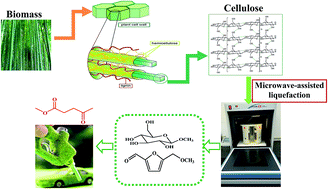当前位置:
X-MOL 学术
›
Sustain. Energy Fuels
›
论文详情
Our official English website, www.x-mol.net, welcomes your
feedback! (Note: you will need to create a separate account there.)
Selective catalytic conversion of waste lignocellulosic biomass for renewable value-added chemicals via directional microwave-assisted liquefaction†
Sustainable Energy & Fuels ( IF 5.0 ) Pub Date : 2018-02-22 00:00:00 , DOI: 10.1039/c7se00579b Junfeng Feng 1, 2, 3, 4, 5 , Jianchun Jiang 1, 2, 3, 4 , Chung-yun Hse 5, 6, 7, 8 , Zhongzhi Yang 1, 2, 3, 4 , Kui Wang 1, 2, 3, 4, 9 , Jun Ye 1, 2, 3, 4 , Junming Xu 1, 2, 3, 4
Sustainable Energy & Fuels ( IF 5.0 ) Pub Date : 2018-02-22 00:00:00 , DOI: 10.1039/c7se00579b Junfeng Feng 1, 2, 3, 4, 5 , Jianchun Jiang 1, 2, 3, 4 , Chung-yun Hse 5, 6, 7, 8 , Zhongzhi Yang 1, 2, 3, 4 , Kui Wang 1, 2, 3, 4, 9 , Jun Ye 1, 2, 3, 4 , Junming Xu 1, 2, 3, 4
Affiliation

|
Selective catalytic conversion of biomass waste for producing methyl levulinate (MLA) via directional microwave-assisted liquefaction was investigated. The goal of the study was to develop a directional liquefaction process using dielectric heating with microwave energy. The methanolysis of biomass into methyl levulinate was studied in the presence of several acid catalysts. The C6 sugar substrates in biomass were successfully converted into methyl levulinate under the optimized conditions (180 °C, 40 min) with a yield of 29.39 wt%. 5-Hydroxymethyl furfural, glucose, fructose, cellobiose, corn starch, and microcrystalline cellulose were selected as models for directional microwave-assisted liquefaction. Therefore, the possible reaction pathway of biomass to methyl levulinate could be investigated. The selective catalytic conversion of biomass was found to be highly efficient for the generation of MLA (reaching a maximum yield of approximately 30 wt%), higher than the levulinic acid yield (14 wt%) in aqueous solution under the same reaction conditions. The results suggested that directional microwave-assisted liquefaction is an effective method that can produce a high value-added fuel additive (methyl levulinate) from lignocellulosic biomass under designated reaction processes.
中文翻译:

通过定向微波辅助液化 将木质纤维素废生物质选择性催化转化为可再生增值化学品†
生物质废物的选择性催化转化,可通过以下途径生产乙酰丙酸甲酯(MLA)对定向微波辅助液化进行了研究。该研究的目的是利用介电加热和微波能来开发定向液化过程。在几种酸催化剂的存在下,研究了生物质甲醇分解为乙酰丙酸甲酯的过程。在最佳条件下(180°C,40分钟),生物质中的C6糖底物成功转化为乙酰丙酸甲酯,收率为29.39 wt%。选择5-羟甲基糠醛,葡萄糖,果糖,纤维二糖,玉米淀粉和微晶纤维素作为定向微波辅助液化的模型。因此,可以研究生物质与乙酰丙酸甲酯可能的反应途径。发现在相同反应条件下,生物质的选择性催化转化对于MLA的产生是高效的(达到约30重量%的最大产率),高于在水溶液中的乙酰丙酸产率(14重量%)。结果表明定向微波辅助液化是一种可以在指定的反应过程中从木质纤维素生物质生产高附加值燃料添加剂(乙酰丙酸甲酯)的有效方法。
更新日期:2018-02-22
中文翻译:

通过定向微波辅助液化 将木质纤维素废生物质选择性催化转化为可再生增值化学品†
生物质废物的选择性催化转化,可通过以下途径生产乙酰丙酸甲酯(MLA)对定向微波辅助液化进行了研究。该研究的目的是利用介电加热和微波能来开发定向液化过程。在几种酸催化剂的存在下,研究了生物质甲醇分解为乙酰丙酸甲酯的过程。在最佳条件下(180°C,40分钟),生物质中的C6糖底物成功转化为乙酰丙酸甲酯,收率为29.39 wt%。选择5-羟甲基糠醛,葡萄糖,果糖,纤维二糖,玉米淀粉和微晶纤维素作为定向微波辅助液化的模型。因此,可以研究生物质与乙酰丙酸甲酯可能的反应途径。发现在相同反应条件下,生物质的选择性催化转化对于MLA的产生是高效的(达到约30重量%的最大产率),高于在水溶液中的乙酰丙酸产率(14重量%)。结果表明定向微波辅助液化是一种可以在指定的反应过程中从木质纤维素生物质生产高附加值燃料添加剂(乙酰丙酸甲酯)的有效方法。











































 京公网安备 11010802027423号
京公网安备 11010802027423号